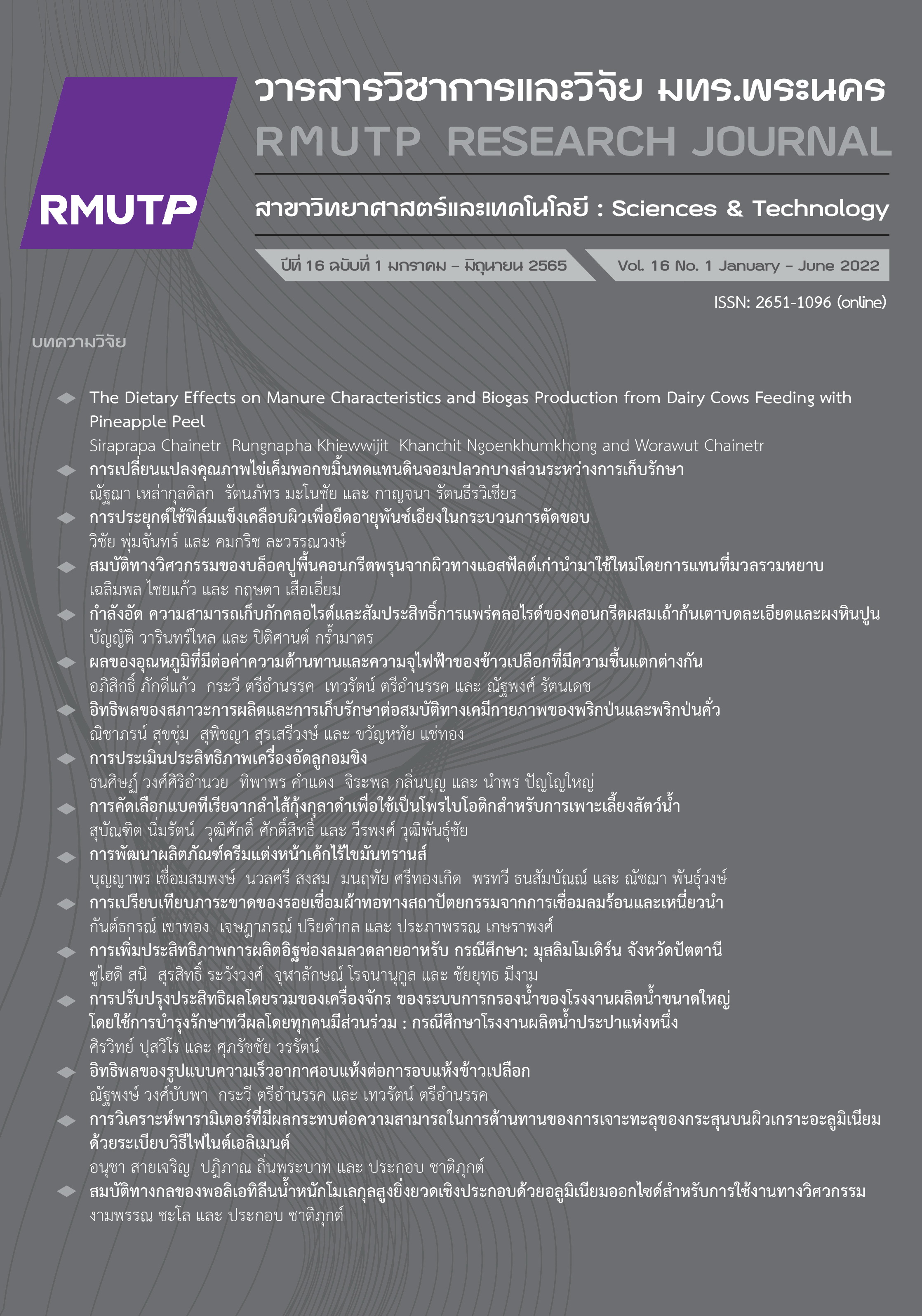The Quality Changes of Coating Salted Eggs with Turmeric to Partially Replace Soil from Termite Mound during Storage
Main Article Content
Abstract
This research aimed to study the quality changes of coating salted eggs partially replacing soil from termite mound with turmeric powder at the level of 0%, 5%, 15% and 25% during storage for 4 weeks. The results showed that the increasing in turmeric level caused a decrease in salt content in raw egg yolk and raw egg white which led to decrease in hardening ratio of egg yolk. The hardness values of cooked - salted egg yolk decreased while those of cooked - salted egg white slightly increased. At the same salting period, the color values of raw egg yolk and raw egg white coated with different levels of turmeric were slightly different. Egg yolks changed to a yellowish orange color while egg whites showed lightness with a direction of red and slightly yellowish color. The raw egg white coated with higher level of turmeric powder exhibited more yellowness which was in accordance with the increasing in curcumin content. From the results of 9-point hedonic scale in terms of color, aroma, overall taste and overall liking, it was found that salted eggs coated with turmeric powder to partially replace soil at a level of 25% with 2 weeks of preserved duration had high scores of sensory acceptability which did not differ significantly from the control samples (0% turmeric) (p>0.05). The curcumin content analyzed in dry egg white was 3.885 mg/g at week 2 and increased to 13.291 and 18.484 mg/g at week 3 and 4, respectively.
Article Details

This work is licensed under a Creative Commons Attribution-NonCommercial-NoDerivatives 4.0 International License.
ลิขสิทธ์ ของมหาวิทยาลัยเทคโนโลยีราชมงคลพระนครReferences
S. Benjakul and T. Kaewmanee, “Sodium chloride preservation in duck eggs,” in Egg Innovation and Strategies for Improvement, P. Hester, Ed. Oxford: Academic Press, 2017, pp. 415–426.
P.V. Kadam, C.L. Bhingare, R.Y. Nikam and S.A. Pawar, “Development and validation of UV Spectrophotometric method for the estimation of Curcumin in cream formulation,” Pharmaceutical Methods, vol. 4, pp. 43–45, Aug. 2013.
R. Anto, J. George, K. Babu, K. Rajasekharan and R. Kuttan, “Antimutagenic and anticarcinogenic activity of natural and synthetic curcuminoids,” Mutation Research, vol. 370, pp. 127–131, Sep. 1996.
AOAC. Official method of analytical chemists, 17th ed. Arlington: The Association of Official Analytical Chemists Inc., 2000.
S. P. Chi and K. H. Tseng, “Physicochemical properties of salted pickled yolk from duck and chicken eggs,” Journal of Food Science, vol. 33, pp. 507–513, Jun. 2008.
Guideline IH. Validation of analytical procedure: text and methodology. Q2 (R1). 2005.
A.V.A. Resurreccion. Consumer Sensory Testing for Product Development, Gaithersburg, Md.: Aspen Publishers, 1998.
S. Apirattananuson, “Coating of chaiya salted eggs with tea waste to partially replace soil from termite mound,” RMUTP Research Journal Science & Technology, vol. 11, no. 1, pp. 111–125, Jan. 2017.
C. W. Lin, “The storage of egg. In the chemistry and utility of egg,” Taipei: Hua shiang Yuan publishing Co. pp. 98–121, 1983.
H. Sugino, T. Nitoda and L.R. Juneja, “General chemical composition of hen eggs,” in Hen Eggs: Their Basic and Applied science, T. Yamamoto, L.R. Juneja, H. Hatta and M. Kim, eds. CRC Press., Boca Raton, Florida, USA, 1996, pp. 13–24.
N. Laokuldilok, N. Panthong, S. Kittipanaprai, T. Tikapanya and P. Taokum, “Application of Ultrasonication Technique for Salting Duck Egg with Turmeric,” in Proceeding of ARUCON 2019, Phranakhon Si Ayutthaya Rajabhat University, Thailand, 2019, pp. 324–330.
T. Kaewmanee, S. Benjakul and W. Visessanguan, “Changes in chemical composition, physical properties and microstructure of duck egg as influenced by salting,” Food Chemistry, vol. 112, pp. 560–569, 2009.
AOAC International. (2020, October). “Requirements for Single Laboratory Validation of Chemical Method,” [Online]. Available: http://www.aoac.org /Official_Methods/ slv guidelines.pdf
D.A. Armbruster and T. Pry, “Limit of blank, limit of detection and limit of quantitation,” The Clinical Biochemist Reviews, vol. 29 suppl (i), pp. S49-S52, Aug. 2008.


